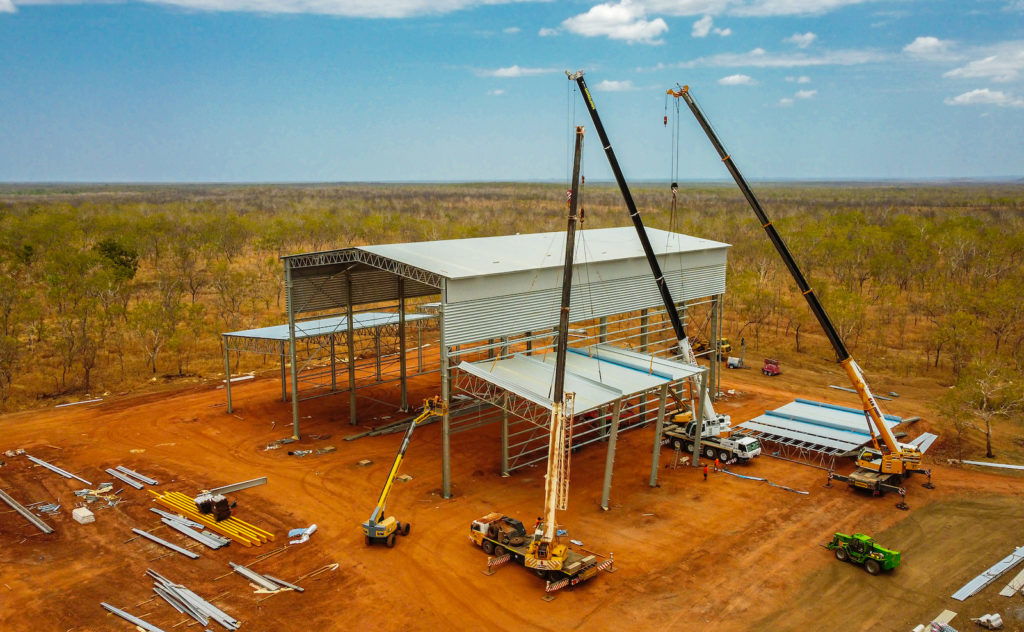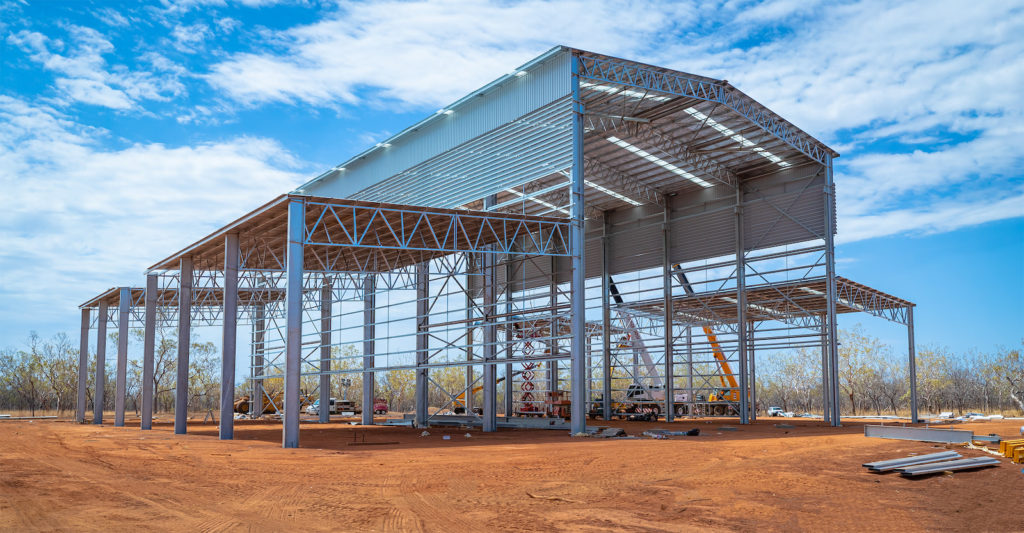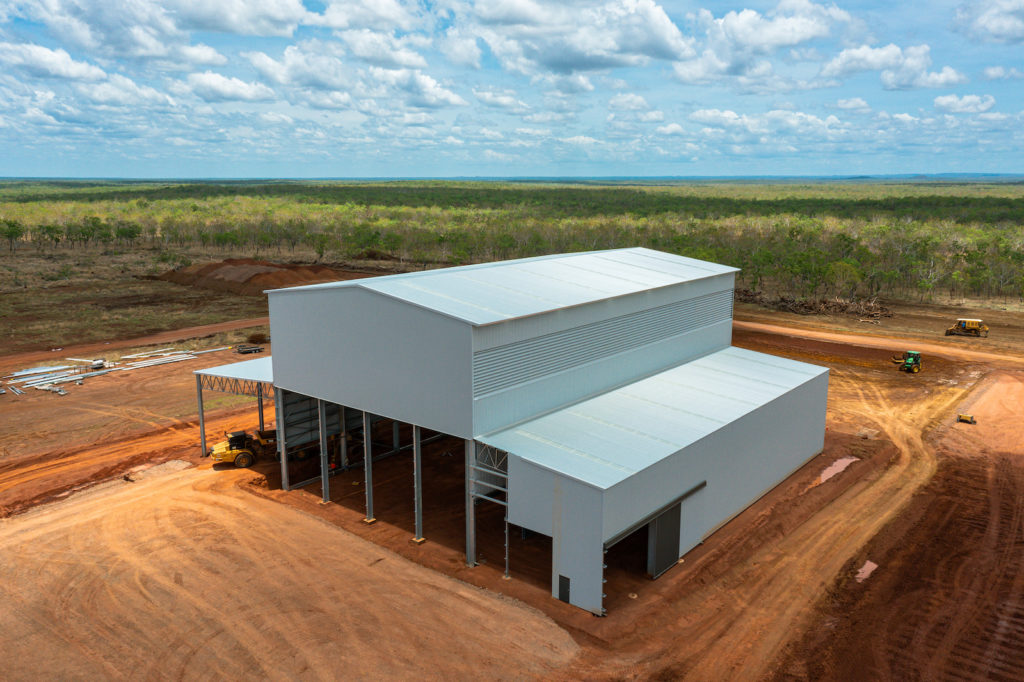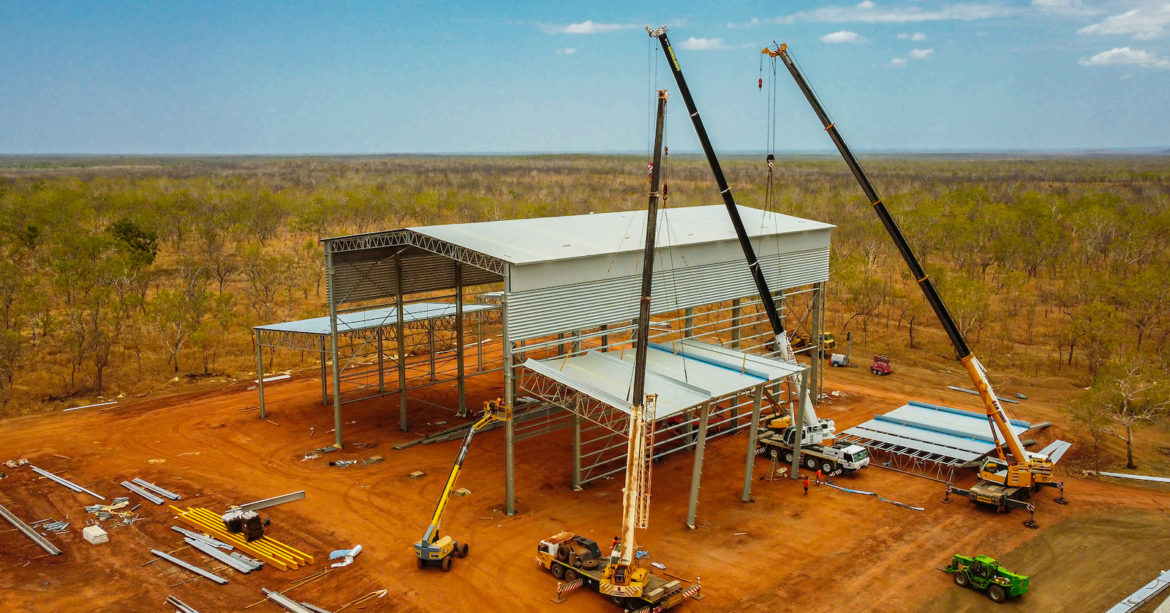Cotton in cattle country, building the Northern Territory’s first gin
The red dirt contrasts the silver sheen of the steel.
Crane’s strategically place sheets of iron on the large columns affixing the roof. These sheets are secured, and the process starts again.
The shed is tall, 21.5 metres at the eave – to be exact – but this detail isn’t initially obvious. There’s no way to compare it – there’s no context in this environment.
The trees bordering the site look tiny in comparison. They stretch as far as the eye can see with dry grass filling the space between.
Key points
- 21.5 metres high
- The shed columns weigh 6 tonne each
- Built at Tarwoo Station, near Katherine
- Some of the machinery has been purchased from former cotton grower Tandou, near Broken Hill, NSW
- This second-hand plant was manufactured by a US company called Consolidated Cotton Co at Lubbock, Texas with new machinery from Lummus Ag Technology, Savannah, Georgia.
Built at Tarwoo Station, near Katherine
About 34 kilometres from Katherine in the Northern Territory, the large steel structure makes a statement.
It’s a cotton gin, in cattle country.
A first for the Territory.
Up front, it represents a boom for infrastructure, business, and another pillar for Northern Territory agriculture.
Scratch the surface and there’s excitement.
It’s now understood that growing cotton in Territory can not only be profitable, but its by-product – cotton seed – provides a valuable and nutritious feed source for cattle.
This structure, the cotton gin, will be the heart of the top-end cotton industry.
It will make the industry viable and competitive with traditional Australian cotton regions.
The gin has also been designed to accommodate growth, proof the industry is expecting big things.
Cotton stacks-up
Sam Buster is the project manager and consultant for this Northern Territory cotton gin.
For him, cotton production in the Territory makes environmental and economic sense.
“In the Northern Territory it is almost all rain-grown,” he said.
“Right now, (that area) grows grass and trees which burns every year and goes up into the atmosphere, or that area runs one cow per 50 hectares. The return on that one cow is minimal compared to 50ha of cotton.”
Expand this thinking to 100ha of cotton, not only would the crop produce fibre, but it would also deliver about 100 tonnes of high protein, high oil cotton seed, according to Sam.
This seed can be used as a cattle feed supplement, something that previously required importation.
Cotton production also diversifies agricultural business in the region.
“It’s another income stream with no relationship to the cattle market,” Sam said. “The income from 1000ha is potentially quite a good income stream. It is intensive cropping, so it also generates a lot of employment.”
Sam has a long family history in the Australian cotton industry and is the Chief Executive of RivCott, a grower-owned gin in the NSW Riverina.
Sam and RivCott have been employed to build and operate this Northern Territory gin.
The next Northern Territory cotton harvest is due to start in June 2022. The gin will be operating a month later.
Revisiting top-end cotton production.
In 2019, five growers in the Northern Territory and Western Australian Kimberly harvested 4,500 bales of cotton as part of a trial.
At the same time, the Northern Territory Government and NT Farmers Association commissioned professional services firm PricewaterhouseCoopers (PwC) to investigate the feasibility of growing cotton in the Northern Territory and generate a business plan for the industry.
Cotton production wasn’t a new concept for the Territory. According to the Norther Territory Government, cotton growing can be traced back to the early 1900s. The Territory Government had also invested in “intensive” cotton research in Katherine from 1993-2006.
The Department of Primary Industry and Resources recommenced research at the Katherine Research Station in 2018. This research concentrated on enhancing the understanding of disease and pest resistance, yield, and fibre quality of new cotton varieties and technologies to support industry viability assessments.
Growers involved in the 2019 trial had to send their unprocessed cotton more than 3,000 km to be processed – ginned – and exported from Queensland. The PwC report found this added an extra 34 per cent to the overall costs for Northern Territory growers to gin and export their product.
In addition, uneconomical transport costs and biosecurity constraints meant the cotton seed -from the Northern Territory grown cotton – could not be transported back from Queensland to benefit the local livestock industry.
A local gin was flagged as the most viable option, with processed cotton exported from the Port of Darwin.
It was touted as a win for cotton growers, the local beef industry, jobs, and the Northern Territory economy.
The Northern Territory Government said the PwC report found a sustainable cotton industry had the potential to contribute $200 million to the Northern Territory economy.
roof lift timelapse
On-farm economics
The colour of the cotton produced during the three-year trial was “beautiful”, the trash content was minimal, and the length and strength of the fibre was good, according to Sam Buster.
The result of “perfect” harvest conditions.
Yield – when compared to irrigated crops – was lower.
But stacked-up against dryland crops, also grown in sandy soils in other parts of the world, such as the US state of Texas, Sam said the Northern Territory harvest fared well.
“They (Texas) average a bale an acre, about 2.4 bales a hectare,” he explained. “It’s the year-in-year-out average. Here it looks like they will average 3-5 bales a hectare.”
There’s about 227kg of cotton lint in a bale, plus about 250kg of cotton seed.
The consistent 1-1.8m rainfall across the Northern Territory growing season would be “ample” for the dryland crop, according to Sam.
By comparison, he said a fully- irrigated cotton crop in the Bourke area of NSW uses only 900mm.
But the problem for the Northern Territory, is that it doesn’t rain for long enough.
“Cotton takes about five months to grow and it only rains for 3.5months,” Sam said. “The yield is limited by the duration of the wet season.”
Despite this constraint, cotton production in the Northern Territory is still a profitable enterprise with a local gin.
Once this was established, attention turned to ensuring the gin operated profitability with its’ small but expanding throughput.

Huge cranes lift the Entegra shed into position
Future focused
Building a feasible gin that’s also suitable to service a growing industry, was a “complete chicken and egg” situation, according to Sam.
For the Territory’s current small cotton crop, a gin isn’t necessarily feasible. But for the industry to grow, it must have a gin.
There was also the problem of cost – at up to $50million – gins’ can be expensive, especially when early cotton production estimates come in at 12,000-20,000 bales a year, far less than the “viable” 120,000 bale a year processing figure, according to Sam.
Then there was the matter of accounting for expected industry growth.
A plan devised with the grower-owners of the gin, involved purchasing a stranded asset gin, built in 1997, from (former cotton grower) Tandou near Broken Hill in NSW.
As one of the youngest gins in Australia, it will remain a part of the operation even with its eight stages of planned growth.
“The gin will never overcapitalise, we will build a small cost-effective gin and as the industry grows, they can capitalise-up commensurate to the production,” Sam said. “That’s the strategy and it’s built into the design of it all. We are building the cheapest, smallest gin you can because that’s all we can afford and all we should have with the production, but it can quickly pivot and grow.”
The first “pivot” point will be 60,000-70,000 bales. Sam said first-year production would be “maxed-out” at 40,000-50,000 bales.
The Entegra Cotton Shed is 21.5 metres high and the shed columns weigh 6 tonne each.
Fit for purpose
Processing dryland cotton, the Katherine gin must have the capacity to handle cotton harvested via spindle-pick and stripper harvesters. The latter delivers a lot more plant material to the gin in the cotton module and this is classified as “gin trash”. As a result, it requires more precleaning machinery, according to Sam.
Under the shed, the cotton gin will include 50-60 machines with the configuration designed for future adjustments.
Logistics was another consideration, and this varied considerably from management at other Australian gins.
Ensuring the gin functioned optimally in Northern Territory conditions meant planning for the risk of winter fires. Practically, this included giving special consideration to the location of the warehouse and the amount of product stored, where the growers will be coming from and their requirements for removing the cotton modules off their farm.
“In the Riverina everyone plants, behind cotton, wheat or a winter crop, they are desperate to get their module off their land,” Sam explained. “But here, no one plants anything behind it, it sits fallow, and it doesn’t rain in winter.”
“The gin site is also surrounded by trees and every year almost everything burns. They have bushfires and they plan on bushfires, there’s expectations that the land surrounding the gin will burn and cotton is highly flammable.”
“RivCott has held, at one point, up to 30,000 modules on our site. A quarter of a billion-dollar value. There’s no way you want to do that here, so our strategy is to feed the gin with just-in-time module freight …. we will never have more than a few days’ supply of modules in our yard to minimise the threat of fire. It will also make it cheaper and more efficient, with no downside to the grower.”

21.5 metres high and the shed columns weigh 6 tonne each
A “privilege” to be involved
Victorian shed company Entegra was commissioned to build the gin on behalf of the WANT Cotton Company Pty Ltd – a group of Western Australian and Northern Territory cotton growers.
The gin will be operated by the Northern Cotton.
This was the first gin constructed by Entegra and its second “landmark” agricultural project the company has built in the Northern Territory.
Entegra director and sales specialist Charles McCalman said it was an honour to work on such an important project for the Territory’s agricultural industry.
“It has been a privilege to be part of WANT Cotton’s journey into northern Australian cotton,” he said.
“We understand the important of this landmark project and know that it must be delivered with uncompromised quality. Entegra does that, through its experience working in regional and rural Australia and its integrity.”
Timelapse of the Entegra shed build of the first cotton gin in the Northern Territory
Industry first thrill
Processing at a new gin starts slow, according to Sam.
It’s expected to begin in July 2022 with RivCott employees operating the gin and training local staff.
Sam said local growers have been optimistic about the gin and the budding cotton industry while southern cotton growers have recognised an opportunity.
“There are a lot of southerners coming in, looking to buy land, because they see the potential,” he said.
“They know it will only be viable if there is a local gin…. they understand cotton completely and see a huge opportunity here.”
As construction continues, the scale of the venture and value it could deliver for the Northern Territory isn’t lost on anyone.
“The opportunity that the growers and the people building and operating the gin have, is to do something that hopefully will be very successful, for the very first time and in a brand-new industry for the Territory,” Sam said.
“It has never been done before and its seldom you get the opportunity to be the first.”

Fitout and construction will continue into the new year
RELATED ARTICLES
The phone call that changed everything – University of New England (UNE)
Minister supports NT agriculture supply chain – Entegra Signature Structures
NT Farmers & the Kenneth Rayner Scholarship – Entegra Signature Structures
Seaweed secret to curbing emissions – Entegra Signature Structures
Feedlot animal efficiency helps cut beef sector emissions – Entegra Signature Structures
FeedTest kits for Entegra clients – Entegra Signature Structures

